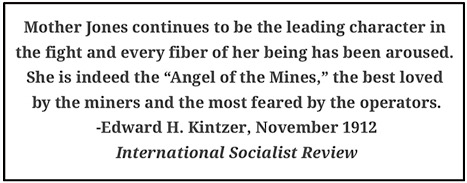 —————
—————
Hellraisers Journal – Tuesday February 18, 1913
Pratt, West Virginia – Mother Jones, Editor Boswell Held Under Martial Law
From the Akron Beacon Journal of February 17, 1913:
 —————
—————
Hellraisers Journal – Tuesday February 18, 1913
Pratt, West Virginia – Mother Jones, Editor Boswell Held Under Martial Law
From the Akron Beacon Journal of February 17, 1913:
 —————
—————
Hellraisers Journal – Monday February 17, 1913
Charleston, West Virginia – Mother Jones, Editor Boswell, and Organizers Arrested
From The Pittsburgh Post of February 14, 1913:
“MOTHER” JONES ARRESTED;
MINE TOWN CAPTURED
———-
Socialists Charged With Inciting Rioting;
Militia Surrounds Miners’ Village.
———-RIOT CALL AT CAPITOL
———-(SPECIAL TO THE POST.)
CHARLESTON, W. Va., Feb. 13.-The arrest of “Mother” Jones, famous agitator; C. H. Boswell, editor of a Socialist paper in this city; Paul J. Paulson [Paulsen], of the international organization of the United Mine Workers of America; Frank Bartley [Charles Batley], a Socialist leader, and others here today, brought rapid developments in the Paint Creek strike situation.
“Mother” Jones and her associates are charged with conspiracy and as accessories before the fact in the death of Fred Bobbett, bookkeeper of the Paint Creek Colliery Company in Mucklow. “Mother” Jones, in a speech in Boomer last night is alleged to have urged the miners to come to Charleston today and “take” the capital. She was arrested this afternoon on one of a number of warrants issued, and with her associates will be taken before the military commission.
“Mother Jones” is reported as having said:
Buy guns, and buy good ones; have them where you can lay your hands on them at any minute. I will tell you when and where to use them.
Mother Jones, it is reported, held a meeting in Longacre, two miles below Boomer, at 10 o’clock this morning, and urged striking union miners to refuse to heed orders of the union president to return to work.
A rumor that miners were coming here to take the State capitol caused a sensation. When some miners and citizens began to gather a riot call was sent in from the capitol building, and the local police under Chief Albert Guill rushed to the State house. The streets about the building were crowded with people, most of whom, however, were drawn there by the riot call.
CAPTURE WHOLE VILLAGE.
Detachments from the troops stationed in the strike zone this morning surrounded the village of Holly Grove, which has been the hotbed of trouble makers since the strike broke out, and captured 68 men. With the men a large quantity of arms and ammunition was also taken. Every man in the little town, which is composed of tents and huts, was taken into custody. The women and children were not disturbed.
According to the military officials commanding in the strike zone, all the rioting and attacks made on troops and workmen have had their inception in Holly Grove. It was from this rendezvous that the strikers were wont to sally forth in parties and fire on the guards and others, in the Paint Creek valley. At the time the raid and arrests were made the population of Holly Grove was far below normal. Ordinarily there are several hundred strikers in the little town.
The 68 men arrested were taken to Paint Creek Junction and placed under a strong guard. With the 60 men who had been arrested previously and taken to Paint Creek Junction, today’s arrests swell the number in custody of the militia officials at that point to 128 men.
EXPECT TO CONVICT RIOTERS.
The militia admit they may not be able to prove that all the prisoners were implicated in the disorders in the Paint Creek region, but that they will be able to connect many of the suspects with the outrages, they say they have no doubt.
According to the civil authorities, who were in charge in Mucklow during the battle fought at that point last Monday night, the men implicated came from Holly Grove, and after the trouble had quieted down, returned to the little village and hid their arms.
The military authorities have not been able to get a copy of the proclamation issued by the miners in the Smithers Creek district, which declared they would “tear the heart of the sheriff, kill the governor and wipe the militia off the map,” although it is said that copies of these proclamations were posted in many conspicuous places throughout the district. Especially were copies of the notice freely distributed throughout the district where the foreign population is in the majority.
Four additional companies of militia were ordered to the strike district to-night by Governor Glasscock. Two are from Parkersburg, and one each from Morgantown and Sutton. Six companies are now in the field.
SAYS DEATH LIST IS 28.
HUNTINGTON, W. Va., Feb. 13.-That the death list in the Cabin Creek riot will total 26 instead of 16, is the statement of W. O. Robbett [Bobbitt], a mine superintendent, who brought his brother, Bob Robbett [Fred Bobbitt] who was killed in the riot, to this city for burial. Mr. Robbett [Bobbitt] made the positive statement that there were 24 miners and two mine guards, one of whom was his brother, a volunteer, killed.
[Photograph and emphasis added.]
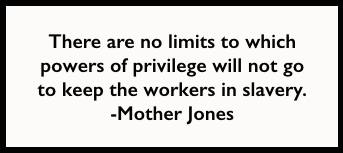 —————
—————
Hellraisers Journal – Thursday February 13, 1913
Holly Grove, West Virginia – Mother Jones Speaks at Funeral of Francis Estep
From The Washington Times of February 11, 1913:
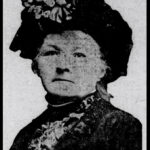
Cesco Estep, striker…was buried yesterday [February 10th near Holly Grove, West Virginia]. At his funeral, “Mother” Jones made an appeal to the men to get their guns and “Shoot them to hell,” meaning the mine watchmen and others who will not join their ranks.
[Emphasis added.
Note: Initial reports, in newspapers across the nation, claim that a striking miner, “Robert Estep,” was killed during rioting at Mucklow. In fact the striking miner killed was Francis Estep, member of the United Mine Workers of America. He was murdered at Holly Grove by gunthugs firing upon men women and children from a train-car called the “Bull Moose Special.” The attack was perpetrated against the small village at about 10 p. m. Residents scrambled for shelter and few miners were able to respond to the attack in an attempt to defend their families.
From the Richmond Times Dispatch (Virginia) of February 9, 1913:
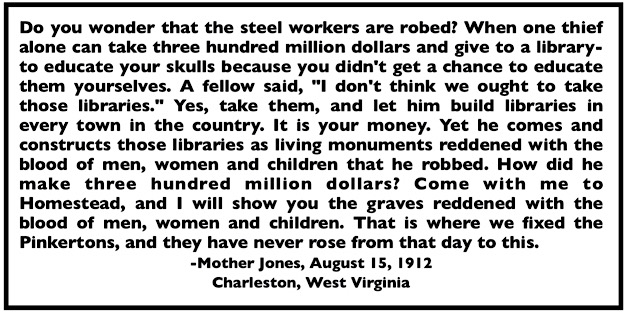 —————
—————
Hellraisers Journal – Sunday February 9, 1913
Carnegie’s Bloody “Pedestal of Fame” by Art Young
From The Coming Nation of February 8, 1913:
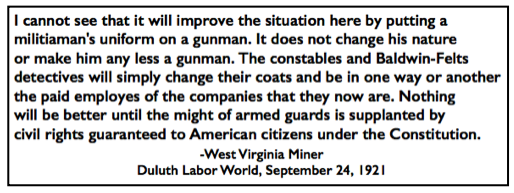 —————
—————
Hellraisers Journal – Saturday February 8, 1913
“Direct Action!” by John Sloan (Government by Gunthug)
From The Masses of February 1913:
Continue reading “Hellraisers Journal: From The Masses: “Direct Action!” by John Sloan”
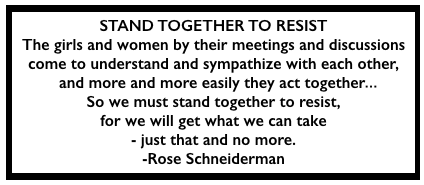 —————
—————
Hellraisers Journal – Wednesday February 5, 1913
New York, New York – The Garment Strike by Mary Marcy, Photos by Paul Thompson
From the International Socialist Review of February 1913:
THE NEW YORK GARMENT WORKERS
By MARY E. MARCYPhotographs by Paul Thompson, New York.
[Part III of III]
Unlike the Lawrence strike, the strike of the New York garment workers is from the top DOWN; that is the union officials ordered the strike and have held the reins in their hands ever since. Without doubt they are trying to serve the strikers, but it is our opinion that they would build more permanently in permitting the strikers themselves to have the deciding voice in their own affairs; in teaching them self-reliance and class solidarity.
But the workers are finding out many things for themselves. They are thrilling with a new sense of power; they are learning the joy that comes when workers of whatever race or creed fight side by side in a great class struggle. The hope of victory and achievement is in the air and it is doubtful whether they will obey any orders from the union officials if their employers do not grant them appreciable benefits.
The heart of every true Socialist is with the strikers in this fight. We believe that the strike is a valuable form of direct action that teaches working class self-reliance and solidarity better than anything else. It teaches the workers to conduct their own fights. It brings out the class character of all existing social institutions. It teaches above all things, the necessity of revolutionary class unionism.
—————
 —————
—————
Hellraisers Journal – Tuesday February 4, 1913
New York, New York – The Garment Strike by Mary Marcy, Photos by Paul Thompson
From the International Socialist Review of February 1913:
THE NEW YORK GARMENT WORKERS
By MARY E. MARCYPhotographs by Paul Thompson, New York.
[Part II of III]
The thugs employed by the shop bosses have proved very energetic and reliable. They have worked early and late beating up strikers whenever possible, starting trouble and blaming it on the workers, while the police stood by (or took a hand) to see that nobody attacked or injured them.
During the first week in January the union officials conferred with the employers relative to a settlement of the strike, but the New York Call reports that all negotiations were broken off when the employers insisted upon a return of the strikers to the shops pending an investigation of the conditions in the trade by a special commission to be appointed for that purpose. The union officials declared that under no circumstances would “they order the men to return to work” pending an investigation or arbitration of their demands.
As the pickets began to suffer at the hands of the company guards, it was decided to take a lesson from the strikers at Lawrence, Mass., and chain picketing was employed for the first time in New York City.
Ten thousand pickets were asked to report each day, starting to work on the “Chain Picket Line” at 5 :00 o’clock in the morning, to pass constantly in a steady stream of pedestrians before the strikebound shops.
On the day of the inauguration of the Chain Picket plan, the unions held various meetings which were well attended by the strikers. Hugh Frayne urged a general strike in every branch of the needle and garment industries, promising the support of the A. F. of L. while Abe Cahan closed one meeting begging the strikers to be true to the American Federation of Labor. He urged them to carry an A. F. of L. card in one pocket and a Socialist party card in the other (that is to work for class organization on one side and craft division on the other.)
This is very different from the calls of the Industrialists, all of whom insist upon a CLASS UNION card on the industrial field and a Socialist party card to represent their class interests upon the political field.
 —————
—————
Hellraisers Journal – Monday February 3, 1913
New York, New York – The Garment Strike by Mary Marcy, Photos by Paul Thompson
From the International Socialist Review of February 1913:
[Part I of III]
A WALKOUT which may yet involve every garment worker in the nation, was started in New York City, December 30th, when scores of thousands of men and women employed in the garment industries responded to the call issued by the United Garment Workers of America and deserted the shops and benches where they had toiled for years.
The response to the strike call was so great that the union officials declared the union was a great deal stronger than they had believed. One thousand five hundred volunteer red scouts, who were picked to carry the official strike declaration, were on the job at 4:00 o’clock in the morning ready to start out with bundles of strike orders to be distributed in all sections of the Lower East Side. Before night over 100,000 men, women and children had taken their working paraphernalia home to begin the good fight.
The garment workers are striking for:
The abolition of the subcontracting system.
The abolition of foot power.
That no work be given out to be done in tenement houses.
Overtime to be paid for at the rate of time and one half, double time for holidays.
A forty-eight hour work week.
A general wage increase of 20 per cent for all the workers in the garment industry.The following scale of wages:
Operators-First class, sewing around coats, sewing in sleeves, and pocket makers, $25 per week; second class, lining makers, closers and coat stitchers, $22; third class, sleeve makers and all other machine workers, $16.
Tailors-First class, shapers, underbasters and fitters, $24; second class, edge basters, canvas basters, collar makers, lining basters and bushelers, $21; third class, armhole basters, sleeve makers, and all other tailoring, $17.
Pressers-Bushel pressers, $24; regular pressers, second class, $24; underpressers and edge pressers, $18.
Women and Child Workers-Button sewers and bushel hands, $12; hand buttonhole makers, first class, 3½ cents; second class, sack coats, 2½ cents; feller hands, not less than $10 a week.
 —————
—————
Hellraisers Journal – Sunday February 2, 1913
Mr. Block by Ernest Riebe Now Found in Pages of the Spokane Industrial Worker
From the International Socialist Review of February 1913:
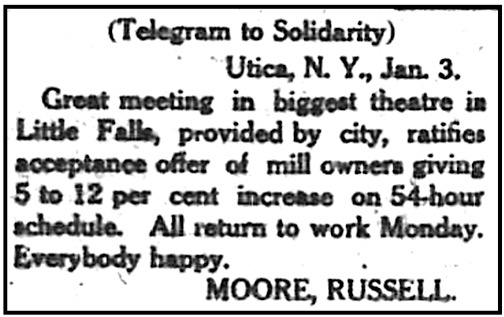 -from Solidarity of January 11, 1913
-from Solidarity of January 11, 1913
—————
Hellraisers Journal – Saturday February 1, 1913
Fourteen Strikers, Organizers and Speakers of Little Falls Strike Remain in Jail
From the International Socialist Review of February 1913:
IN the Herkimer County jail at Herkimer, N. Y., are fourteen strikers, organizers and speakers-Legere, Bocchini, Vaughn, Hirsh, Lesnicki, Wladya, Morlando, Preta, Scitrona, Bianco, Flamena Cornacchio, Furillo and Capuano. They must stand trial on serious charges because the authorities of Little Falls and Herkimer county hold that:
Ten persons who gather together during a strike constitute a “riot.”
An open-air meeting in which quotations from the Bible, Declaration of Independence and Constitution of the United States are read constitutes “an unlawful assemblage.”
Speakers who encourage strikers to stand firm but urge them to be peaceful and orderly are guilty of “inciting to riot.”
Organizers who are present in an orderly assemblage which is broken up by police and in which two detectives are hurt by unknown persons must face long terms in jail for “assault in the first degree.”
Workingmen who are members of a strike committee are conspirators and should be locked up where their influence will not be felt.
If convictions are obtained in these cases then the working class of America might as well abandon all agitation and education both for political and economic action unless they are prepared to serve from one to ten years in the penitentiary.
The Little Falls strike is over, but the big fight has just begun. The commonest rights of human beings and citizens have once more been annulled and spit upon by the capitalist class and their legal lackeys. Are they going to be allowed to get away with it? These cases were originally set for the second week in January, but they may be continued. Meantime send your protests to Governor Sulzer at Albany, N. Y., who says he is the “workingman’s friend”; to District Attorney Farrell at Ilion, N. Y., and Mayor Shall at Little Falls, N. Y. It is time the voice of labor be heard.
—————
[Emphasis added.]